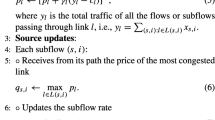Abstract
Integration of multicast and unicast data in future radio access networks will be necessary in order to improve the resource efficiency and provide new services. Such integration requires new and efficient resource sharing mechanisms. These mechanisms need to be optimized to provide the best possible trade-off between resource efficiency and fairness. In this article, we consider a case where streaming multicast users are multiplexed together with elastic unicast users on a common time-slotted channel. We derive a system model to study the performance of various resource allocations strategies under proportional and resource fairness constraints. Fairness is directly defined in terms of the users’ utilities rather than of the throughputs they are assigned to. We also describe an extension of the well-known unicast proportional fair scheduler to the multicast scenario. Through extensive simulations we demonstrate the performance of this scheduler for various traffic loads and multicast group sizes.















Similar content being viewed by others
References
Ericsson, MBMS for E-UTRA, R1–060574, 3GPP TSG-RAN Working Group 1.
Zhu, W., & Song, M. (2006). Integration of unicast and multicast scheduling in input-queued packet switches. Computer Networks, 50(5), 667–687.
Minkenberg, C. (2000). Integrating unicast and multicast traffic scheduling in a combined input- and output-queued packet-switching system. In Proc. Int. Conf. Computer Communications and Networks (ICCCN), Las Vegas, NV, pp. 127–134.
Mhamdi, L., & Vassiliadis, S. (2006). Integrating uni- and multicast scheduling in buffered crossbar switches. In Proc. IEEE Workshop on High Performance Switching and Routing (HPSR), Poznan, Poland, pp. 99–104.
Filali, F., & Dabbous, W. (2004). Fair bandwidth sharing between unicast and multicast flows in best-effort networks. Computer Communications, 27(4), 330–344.
Miao, G., & Niu, Z. (2006). Bandwidth management for mixed unicast and multicast multimedia flows with perception based QoS differentiation. In Proc. IEEE Int. Conf. Communications (ICC), Vol. 2, Istanbul, Turkey, pp. 687–692.
Briscoe, B. (2007). Flow Rate Fairness: Dismantling a Religion. ACM Computer Communications Review, 37(2), 63–74.
Kelly, F., Maulloo, A., & Tan, D. (1998). Rate control in communication networks: shadow prices, proportional fairness and stability. Journal of the Operational Research Society, 49, 237–252.
Le Boudec, J. Y. (2007). Rate adaptation, congestion control and fairness: A tutorial. Dec. 2006. http://ica1www.epfl.ch/PS_files/LEB3132.pdf. Accessed 20 June 2007.
Motorola and Nokia, Revised HSDPA CQI proposal, R4–020612, 3GPP TSG-RAN Working Group 4.
Rodriguez, V., Goodman, D. J., & Wang, Y. (2004). Optimal coding rate and power allocation for the streaming of scalably encoded video over a wireless link. In Proc. IEEE Int. Conf. Acoustics, Speech, and Signal Processing (ICASSP), Vol. 5, Montreal, pp. 985–988.
Viswanath, P., Tse, D., & Laroia, R. (2002). Opportunistic Beamforming Using Dumb Antennas. IEEE Transactions on Information Theory, 48(6), 1277–1294.
Avidor, D., Ling, J., Mukherjee, S., & Papadias, C. (2004). On some properties of the proportional fair scheduling policy. In Proc. IEEE Int. Symp. Personal, Indoor and Mobile Radio Comm. (PIMRC), Barcelona, Spain, pp. 853–858.
Bonald, T., Borst, S. C., & Proutiere, A. (2004). How mobility impacts the flow-level performance of wireless data systems. In Proc. IEEE Infocom, Vol. 3, Hong Kong, pp. 1872–1881.
Baskett, F., Chandy, K. M., Muntz, R. R., & Palacios, F. G. (1975). Open, closed and mixed networks with different classes of customers. Journal of the ACM, 22(2), 248–260.
Liu S., & Virtamo, J. (2005). Performance analysis of wireless data systems with a finite population of mobile users. In Proc. 19th International Teletraffic Congress (ITC), Beijing, pp. 1295–1304.
Schweitzer, P. (1979). Approximate analysis of multiclass closed networks of queues. In Proc. Int. Conf. Stochastic Control and Optimization, Amsterdam, pp. 25–29.
Stolyar, A. (2005). On the asymptotic optimality of the gradient scheduling algorithm for multi-user throughput allocation. Operations Research, 53(1), 12–25.
Agrawal, R., & Subramanian, V. (2002). Optimality of certain channel-aware scheduling policies. In Proc. 40th Annual Allerton Conf. Commun., Control, and Comp., Monticello, IL, pp. 1532–1541.
Bai, F., Sadagopan, N., & Helmy, A. (2003). IMPORTANT: A framework to systematically analyze the Impact of Mobility on Performance of RouTing protocols for Ad-hoc NeTworks. In Proc. of Infocom, San Francisco, CA.
Author information
Authors and Affiliations
Corresponding author
Rights and permissions
About this article
Cite this article
Vukadinović, V., Karlsson, G. Multicast scheduling with resource fairness constraints. Wireless Netw 15, 571–583 (2009). https://doi.org/10.1007/s11276-007-0085-y
Published:
Issue Date:
DOI: https://doi.org/10.1007/s11276-007-0085-y




